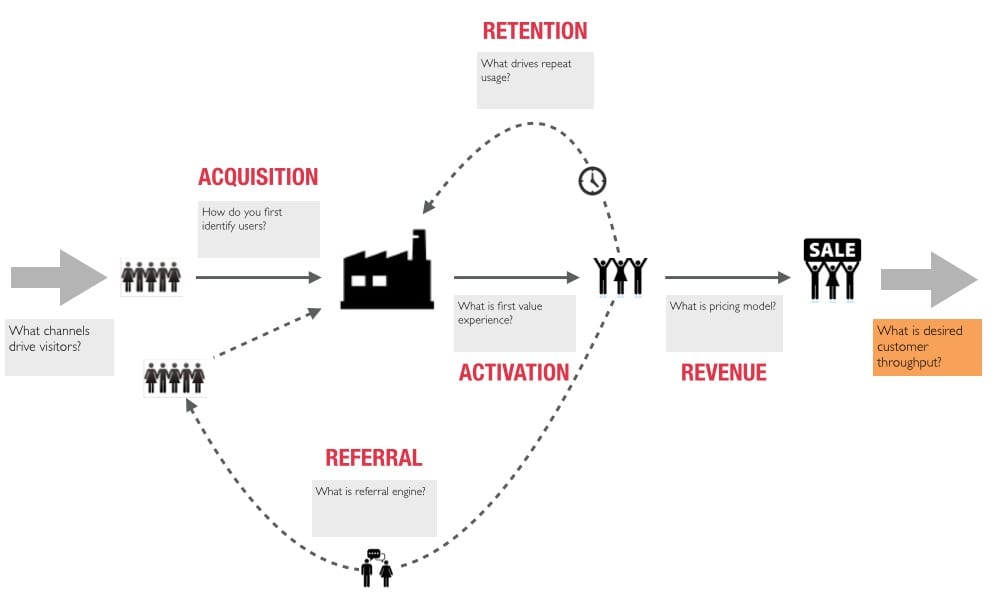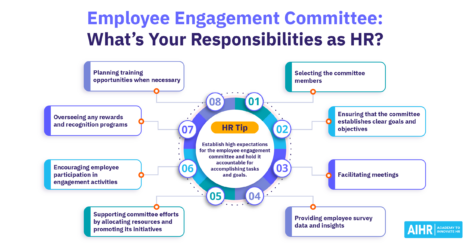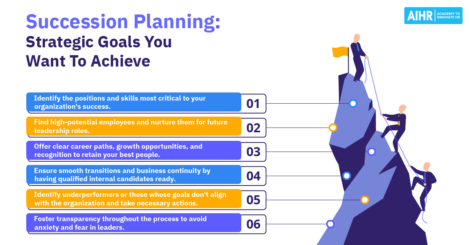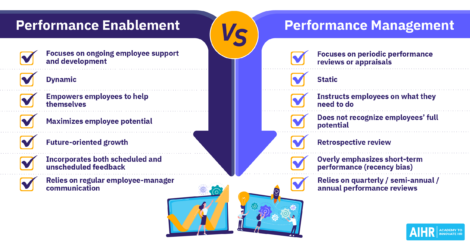A New HR Talent Management Model

A lot of people – including us – are looking for a talent management model but so far, no one has developed such a model yet. This article, therefore, introduces a talent management model you can use in order to get the most out of your employees.
The AARRR model
Back in the day, I taught entrepreneurship to university students. One of my favorite models to explain startup marketing was the pirate – or AARRR – model (originally by Ash Maura). I usually introduced it by asking: “What does a pirate smoke? A cigAARRR!”
The AARRR model shows how customers first get in touch with an organization and eventually end up buying something from that organization. This happens in five phases.
- Acquisition: This is all about driving visitors to the organization.
- Activation: The first value experience that is exchanged between the organization and the customer. This can be a customer that leaves their email address in exchange for a monthly newsletter for example.
- Revenue: The first and most important of the R’s. Revenue is about getting customers to make a purchasing decision. Needless to say, this is the lifeblood of the company.
- Referral: How do you get customers to tell others about you so you get even more customers?
- Retention: How do you retain those buying customers so they come back and buy again?
Of course, now I could tell you a lot about how useful this model is and how you can use different media channels to acquire and activate customers, encourage them to make purchasing decisions, et cetera.
The big question, however, is: how can we apply this model to HR?
The HR Talent Management Model
When we need to create a talent management model, the marketing model I just described works as a perfect template. Employees go through the exact same process as customers.
In addition, working with a similar model helps to think about employees as ‘internal customers’. And seeing employees as customers helps us to push for customer, or service excellence. This is an area where HR can still learn a lot from related disciplines like sales and marketing.
So, let’s get started. First off, here’s the HR Talent Management Model:
Now let me walk you through the 5 steps that every employee goes through in this talent management model.
Acquisition
Acquisition is all about attracting potential candidates to your organization. In the recruitment world, this is referred to as employer branding.
- How will you get the word out and get people to know you?
- How will you become an appealing employer that people will want to work for?
- How do you make sure that you are approachable as a company, so you can convert the people that know you into people that will want to apply?
These are fundamental questions that you need to be able to answer when you’re serious about becoming a better employer.
Activation
Activation is about selection, candidate experience and getting people onboarded.
- How will you select the right people from the talent pool that you’ve built?
- How do you make the right selection to avoid bad hires?
- How do you turn candidates into ambassadors? How will you make sure your candidate experience is near perfect?
- How do you reject candidates but still give them the best experience and keep in touch with them for other jobs?
- How do you onboard your people so they will stay with your company and become productive?
These are questions you need to answer in order to make sure that you can hire the best people in the market – and that the people that you decide not to hire go home feeling good.
Revenue
Revenue is about getting the most out of your people. This includes topics like onboarding, learning and development and performance management.
- How do you make sure people are onboarded faster?
- How will you reduce your new hires’ time to full productivity?
- How will you make sure that your people stay competitive and keep performing in the future?
- How will you keep your workforce engaged?
- How will you make sure that people perform to the best of their abilities through effective performance management?
Referral
Referral is about getting new people in and about building your reputation. This can be to attract new employees or to leverage your employees to expand your customer base.
- How do we create an effective employee referral program?
- How can we make our employees champion our brand?
- How do we leverage our employees to expand our customer base?
Employee referral programs are very much in fashion. Employees who are referred usually onboard faster, perform better and are less likely to leave prematurely.
Retention
Just like you want to retain your customers, you want to retain your employees. If your talent thinks your organization is undesirable to work for, you have a big problem. Topics include retention, happiness, and compensation and benefits.
- How will you reduce your voluntary turnover percentage?
- How will you compensate your employees to ensure that they’re happy? Compensation is, of course, not always financial. Non-financial incentives often work just as well, if not better!
- How will you use variable pay to make sure your salespeople perform optimally?
- How will you ensure your organization maintains its reputation as a great place to work?
Retention is about doing everything to keep your best performers. In addition, a good retention policy – and the use of talent management metrics – helps to build a competitive advantage. If your best employees never leave, you will outperform your competition.
As you can see, the HR Talent Management Model helps to structure and optimize all your talent activities.
Related: 9 Talent Management Metrics You Need to Use
The HR Talent Management Model in Practice
Alright, let’s look at some examples now.
Acquisition & Retention: Employer Branding and rewards at Pret a Manger
I don’t know if you’ve ever been to a Pret a Manger to grab a cup of coffee or a healthy snack, but if you have, you’ll know what I’m talking about. Whenever you enter a Pret store, nine times out of ten the staff is genuinely friendly and smiley without it coming across as fake.
How’s that possible right? I was asking myself the same question.
Several factors play a role here, of course. One of them is this rule they have at Pret that whenever a customer makes an employee smile – just by wishing them a good day or cracking a friendly joke – employees are allowed to give the customer a freebie. The result? Customer happy, employee happy, business happy!
Another important element is that Pret doesn’t hire based on previous experience but based – among others things – on whether or not candidates conform with the company’s core behaviors: passion, clear talking and team working. All good examples of practices that made Pret a Manger such an attractive employer.
In addition to attracting employees, Pret’s practices also had a direct impact on the company’s retention rates: annual turnover has dropped from 90% to 60% (in 2015) which is an incredibly solid number for the industry Pret is in. What’s more, 80% of the managers at Pret a Manger started out as team members.
Activation: Selection, candidate experience and onboarding at Dignity Health
Dignity Health ranked number one in Glassdoor’s 2017 ‘Top Five Best Places to Interview in the US’ list. When asked how you build a great candidate experience Kristie Griffin, Director of Talent Acquisition at Dignity Health mentioned the following:
- Prepare the candidate
- Focus on values as much as skills
- Standardize values evaluation
- Put the candidate at ease
Other companies in the top five named things such as ask the interviewers to share their personal journey, let candidates know where they stand and create a guide for interviewers. All great examples of Talent Activation done right.
Revenue: Learning and development and performance management at Google
A classic example of a company that does performance management differently – and successfully – is Google. The company focusses on employee goal-setting instead of formal ranking. Google staff sets their own so-called objective and key results (OKRs) and managers try to coach employees towards creating and achieving their goals. This creates buy-in from the employees on these goals which helps the organization to reach its company goals more effectively.
A talent management model helps to map the employee journey and is a great example of employee-centric Human Resource Management. Can you map your organization on this talent management model?
Special thanks to Nuria Rojo for making some valuable additions to this article.
Weekly update
Stay up-to-date with the latest news, trends, and resources in HR
Learn more
Related articles
Are you ready for the future of HR?
Learn modern and relevant HR skills, online














